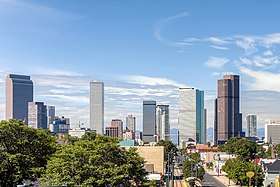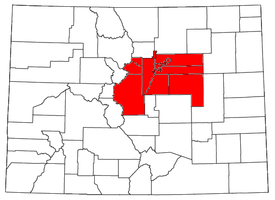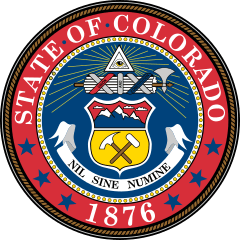Denver metropolitan area
Denver is the central city of a conurbation region in the U.S. state of Colorado. The conurbation includes one continuous region consisting of the six central counties of Adams, Arapahoe, Broomfield, Denver, Douglas, and Jefferson. The Denver region is part of the Front Range Urban Corridor.
Denver Metropolitan Area | |
|---|---|
Metropolitan area | |
| Denver-Aurora-Lakewood, CO MSA | |
 Skyline of Downtown Denver | |
| Country | |
| State(s) | |
| Principal cities | |
| Area | |
| • Metro | 8,344.9 sq mi (21,613 km2) |
| Highest elevation | 5,470 ft (1,670 m) |
| Lowest elevation | 5,130 ft (1,560 m) |
| Population (2019 estimate)[2] | |
| • Metropolitan area | 2,967,239 |
| • Density | 351.4/sq mi (135.7/km2) |
| Ranked 18th in the US | |
| Time zone | UTC−7 (MST) |
| • Summer (DST) | UTC−6 (MDT) |
| Area codes | 303 and 720 |

The United States Office of Management and Budget has delineated the Denver–Aurora–Lakewood, CO Metropolitan Statistical Area consisting of ten Colorado counties: the City and County of Denver, Arapahoe County, Jefferson County, Adams County, Douglas County, the City and County of Broomfield, Elbert County, Park County, Clear Creek County, and Gilpin County.[3] The United States Census Bureau estimates that the population was 2,888,227 as of July 1, 2017, an increase of +13.55% since the 2010 United States Census, and ranking as the 19th most populous metropolitan statistical area of the United States.[4]
The Office of Management and Budget also delineated the more extensive Denver–Aurora combined statistical area comprising the Denver-Aurora-Lakewood Metropolitan Statistical Area, the Boulder Metropolitan Statistical Area, and the Greeley Metropolitan Statistical Area.[3]
The central part of the metropolitan statistical area (MSA) includes Denver and three immediately adjacent counties: Jefferson County to the west, Adams County to the north and east, and Arapahoe County to the south and east. The continuously urbanized area extends northwest into the City and County of Broomfield, bordering Jefferson and Adams counties, and south into Douglas County, adjoining Arapahoe County. Also included in the federally defined MSA are four rural counties: Elbert County on the southeastern prairie and Clear Creek, Gilpin, and Park counties in the Rocky Mountains.
Counties
The Denver-Aurora-Lakewood Metropolitan Statistical Area comprises ten counties.[5] The sortable table below includes the following information:
- The official name of the county,[6]
- The county population as of July 1, 2017, as estimated by the United States Census Bureau,[7]
- The county population as of April 1, 2010, as enumerated by the 2010 United States Census,[7]
- The percent population change from April 1, 2010, to July 1, 2017.[7]
| County | 2010 Census | 2017 Estimate | Change |
|---|---|---|---|
| City and County of Denver | 600,158 | 704,621 | +17.41% |
| Arapahoe County | 572,003 | 643,052 | +12.42% |
| Jefferson County | 534,543 | 574,613 | +7.50% |
| Adams County | 441,603 | 503,167 | +13.94% |
| Douglas County | 285,465 | 335,299 | +17.46% |
| City and County of Broomfield | 55,889 | 68,341 | +22.28% |
| Elbert County | 23,086 | 25,642 | +11.07% |
| Park County | 16,206 | 17,905 | +10.48% |
| Clear Creek County | 9,088 | 9,574 | +5.35% |
| Gilpin County | 5,441 | 6,013 | +10.51% |
| Total | 2,543,482 | 2,888,227 | +13.55% |
Metropolitan area cities and towns
| Historical population | |||
|---|---|---|---|
| Census | Pop. | %± | |
| 1900 | 162,323 | — | |
| 1910 | 246,767 | 52.0% | |
| 1920 | 299,087 | 21.2% | |
| 1930 | 352,563 | 17.9% | |
| 1940 | 407,768 | 15.7% | |
| 1950 | 563,832 | 38.3% | |
| 1960 | 868,953 | 54.1% | |
| 1970 | 1,116,226 | 28.5% | |
| 1980 | 1,450,768 | 30.0% | |
| 1990 | 1,650,489 | 13.8% | |
| 2000 | 2,157,756 | 30.7% | |
| 2010 | 2,543,482 | 17.9% | |
| Est. 2019 | 2,967,239 | 16.7% | |
| data source:[8][9] | |||
Places with over 100,000 inhabitants
Places with 10,000 to 100,000 inhabitants
- Berkley (Census Designated Place)
- Brighton
- Broomfield
- Castle Rock
- Columbine (CDP)
- Commerce City
- Englewood
- Federal Heights
- Golden
- Greenwood Village
- Highlands Ranch (CDP)
- Ken Caryl (CDP)
- Littleton
- Northglenn
- Parker
- Sherrelwood (CDP)
- Welby (CDP)
- Wheat Ridge
Places with fewer than 10,000 inhabitants
- Acres Green (CDP)
- Applewood (CDP)
- Alma
- Aspen Park (CDP)
- Bailey
- Black Hawk
- Byers (CDP)
- Carriage Club (CDP)
- Pines (CDP)
- Castle Pines North
- Central City
- Cherry Hills Village
- Coal Creek
- Columbine Valley
- Cottonwood (CDP)
- Deer Trail
- Derby (CDP)
- Downieville-Lawson-Dumont
- East Pleasant View (CDP)
- Edgewater
- Elizabeth
- Empire
- Evergreen (CDP)
- Fairplay
- Foxfield
- Franktown (CDP)
- Genesee (CDP)
- Georgetown
- Glendale
- Grand View Estates (CDP)
- Heritage Hills (CDP)
- Idaho Springs
- Indian Hills (CDP)
- Kiowa
- Kittredge (CDP)
- Lakeside
- Larkspur
- Lochbuie
- Lone Tree
- Louviers (CDP)
- Meridian (CDP)
- Montbello (CDP)
- Morrison
- Mountain View
- North Washington (CDP)
- Perry Park (CDP)
- Ponderosa Park (CDP)
- Roxborough Park (CDP)
- Sedalia (CDP)
- Sheridan
- Silver Plume
- Simla
- St. Mary's
- Stonegate (CDP)
- Strasburg (CDP)
- The Pinery (CDP)
- Todd Creek (CDP)
- Twin Lakes (CDP)
- Westcreek (CDP)
- West Pleasant View (CDP)
Communities previously part of the Denver metro area
Former Denver metro communities now part of the separate Boulder metropolitan area due to being located in Boulder County
|
Former Denver metro communities now part of the separate Greeley metropolitan area due to being located in Southwestern Weld County
|
Regional cooperation
The Denver Regional Council of Governments (DRCOG, pronounced Doctor Cog) is a regional planning and inter-governmental coordination organization in a nine-county region. The Scientific and Cultural Facilities District (SCFD) provides funding for scientific and cultural facilities in a seven-county region including:
- The Denver Museum of Nature and Science
- The Denver Zoo
- The Denver Art Museum
- The Denver Center for the Performing Arts
- The Denver Botanic Gardens
In addition, the Regional Transportation District (RTD) provides mass transit, including a light rail system. In 2005 the RTD developed a twelve-year comprehensive plan, called "FasTracks", to build and operate rail transit lines and expand and improve bus service throughout the region.
Economy
The most prosperous parts of the area are in the south, while the most industrialized areas are in the northeast, specifically in the northern part of Denver proper and extending to areas such as Commerce City in Adams County.
Changes in house prices for the area are publicly tracked on a regular basis using the Case–Shiller index; the statistic is published by Standard & Poor's and is also a component of S&P's 10-city composite index of the value of the residential real estate market.
Electricity is provided by Xcel Energy. Cable television is provided by Comcast.[10]
Sports
The following table shows sports teams in the Denver metropolitan area that average more than 12,000 fans per game:
| Club | Sport | League | Venue | City | Capacity | Attendance | Since | Titles |
|---|---|---|---|---|---|---|---|---|
| Denver Broncos | Football | NFL | Mile High | Denver | 76,125 | 76,939 | 1960 | 3 (1998, 1999, 2016) |
| Colorado Rockies | Baseball | MLB | Coors Field | Denver | 50,398 | 31,334 | 1993 | 0 |
| Colorado Avalanche | Ice hockey | NHL | Pepsi Center | Denver | 18,007 | 16,176 | 1995 | 2 (1996, 2001) |
| Colorado Rapids | Soccer | MLS | Dick's Sporting Goods Park | Commerce City | 18,061 | 15,657 | 1996 | 1 (2010) |
| Denver Nuggets | Basketball | NBA | Pepsi Center | Denver | 19,115 | 14,700 | 1967 | 0 |
| Colorado Raptors | Rugby union | MLR | Infinity Park | Glendale | 5,000 | - | 2018 | 0 |
| Colorado Mammoth | Box Lacrosse | NLL | Pepsi Center | Denver | 18,007 | 14,077 | 2003 | 1 (2006) |
Air quality
The center of the metropolitan area sits in a valley, the Denver Basin, and suffers from air pollution known colloquially as the brown cloud, building up if the air is stagnant as it often is in the winter. Severity of pollution in this area has varied enormously over the years. In the late 1980s the area was frequently in violation of multiple National Ambient Air Quality Standards established by the United States Environmental Protection Agency (EPA). The Regional Air Quality Council (RAQC) was formed in 1989 to create plans to address the problem. Through a variety of measures the area's air quality was improved and in 2002 the EPA designated the area in compliance with all federal health-based air quality standards. Denver was the first major city in the United States to reach compliance with all six of these standards after previously violating five of them.[11] Since then the EPA introduced a new standard for small particulates and made the existing ozone standard stricter. In 2003 the new ozone standard was frequently exceeded in the area and was occasionally exceeded as far away as Rocky Mountain National Park. The RAQC hopes to implement plans enabling the area to comply with the new standards by 2007.
Sister cities
Though Aurora, Boulder, Brighton, Broomfield, Denver, Lakewood, and Longmont have their own individual sister city relationships, the Denver Regional Council of Governments (DRCOG) as a whole has a sister city relationship with the Baghdad Governorate of Iraq.[12]
See also
Colorado metropolitan areas
- Colorado census statistical areas
- Combined Statistical Area
- Core Based Statistical Area
- Metropolitan Statistical Area
- Micropolitan Statistical Area
- List of Metropolitan Statistical Areas
- Table of United States Combined Statistical Areas
- Table of United States Metropolitan Statistical Areas
- Table of United States Micropolitan Statistical Areas
- Table of United States primary census statistical areas
- Larger urban regions that contain the Denver–Aurora–Lakewood, CO Metropolitan Statistical Area:
- Core Based Statistical Areas adjacent to Denver–Aurora–Lakewood, CO Metropolitan Statistical Area:
- Boulder Metropolitan Statistical Area
- Cañon City Micropolitan Statistical Area
- Colorado Springs Metropolitan Statistical Area
- Edwards Micropolitan Statistical Area
- Fort Morgan Micropolitan Statistical Area
- Greeley Metropolitan Statistical Area
- Silverthorne Micropolitan Statistical Area
- Other definitions of Colorado urban areas:
- Colorado metropolitan areas
- Denver Metropolitan Area
- Street grid (Denver–Aurora Metropolitan Area)
References
- https://pubs.usgs.gov/gip/Elevations-Distances/elvadist.html
- https://censusreporter.org/profiles/31000US19740-denver-aurora-lakewood-co-metro-area/
- "OMB Bulletin No. 13-01: Revised Delineations of Metropolitan Statistical Areas, Micropolitan Statistical Areas, and Combined Statistical Areas, and Guidance on Uses of the Delineations of These Areas" (PDF). United States Office of Management and Budget. February 28, 2013. Retrieved March 20, 2013.
- "Table 1. Annual Estimates of the Population of Metropolitan and Micropolitan Statistical Areas: April 1, 2010 to July 1, 2012". 2012 Population Estimates. United States Census Bureau, Population Division. March 2013. Archived from the original (CSV) on April 1, 2013. Retrieved March 20, 2013.
- "Annual Estimates of the Population of Metropolitan and Micropolitan Statistical Areas: April 1, 2000 to July 1, 2007" (CSV). 2007 Population Estimates. United States Census Bureau, Population Division. 2008-03-27. Retrieved 2008-03-27.
- "Colorado Counties as of May 1, 2011". State of Colorado, Department of Local Affairs. May 1, 2011. Archived from the original on July 1, 2007. Retrieved May 2, 2011.
- "Annual Estimates of the Resident Population for Counties of Colorado: April 1, 2010 to July 1, 2011". 2011 Population Estimates. United States Census Bureau, Population Division. April 2012. Archived from the original (CSV) on November 14, 2012. Retrieved April 12, 2012.
- "Providence Metropolitan Area:2000–2005 Population & Migration". demographia.com. Retrieved June 11, 2007.
- DIvision, US Census Bureau Systems Support. "Ranking Tables for Metropolitan Areas (PHC-T-3)". www.census.gov.
- "About Provider - Comcast Corporation - Nationwide - National Broadband Map". National Broadband Map. Retrieved 2016-12-23.
- "?" (PDF). Archived from the original (PDF) on December 4, 2004.
- "Bagdad–Denver region partnership". Denver Regional Council of Governments. Archived from the original on 18 June 2012. Retrieved 9 August 2010.
